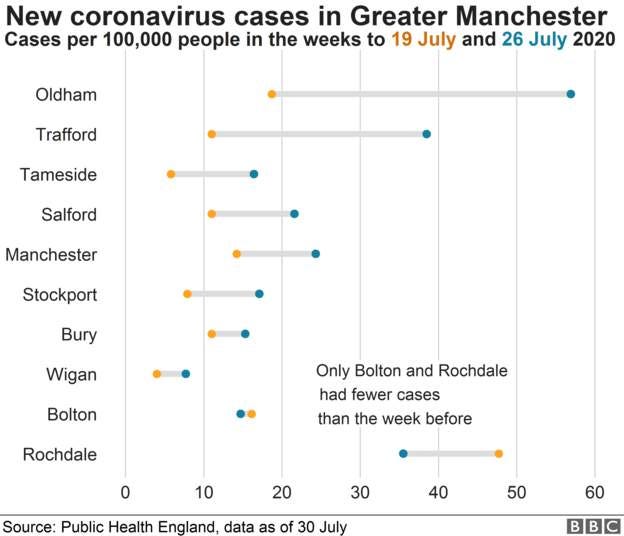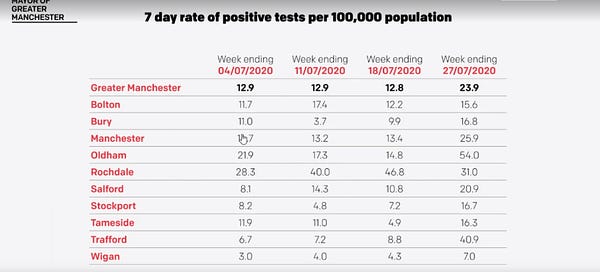The most important details about Greater Manchester's local lockdown
The rules and data you need to know
Good morning. The government has published details of the new lockdown restrictions in Greater Manchester and other areas in the North. The first line is stark: “An outbreak of coronavirus (COVID-19) has been identified in parts of Greater Manchester, East Lancashire, and West Yorkshire.” You can read the full announcement here.
There is a lot of confusing and conflicting information circulating on social media, not to mention a lot of anger at how the government has communicated this news. All of that is understandable. There is also just a very high volume of news coverage about these new restrictions - including more than 20 stories on the MEN website already.
I thought the most useful thing to do was send you a summary of the most important information that we know this morning, so you have it clearly and in one place. The Mill will do this regularly until the local lockdown is lifted. I will stick to published data and on-the-record quotes.
If you think other people will find this useful, you can share it using the button below.
The new rules
The local lockdown is in place as of today and is heavily focused on private homes and gardens. People are free to visit public places and to go to weddings and places of worship but are not allowed to have guests to their homes or to visit other peoples’ homes, even if those people live outside the areas listed.
The government’s announcement says new laws will be passed to prevent people in Greater Manchester and a few bits of East Lancashire and West Yorkshire from meeting people outside their household (and outside their support bubble) in private homes and gardens. It says police will have the power to issue fixed penalty notices for those caught breaking the rules.
As per the announcement, residents of the affected areas should not:
Meet people you do not live with inside a private home or garden, except where you have formed a support bubble (or for other limited exemptions to be specified in law).
Visit someone else’s home or garden even if they live outside of the affected areas.
Socialise with people you do not live with in other indoor public venues – such as pubs, restaurants, cafes, shops, places of worship, community centres, leisure and entertainment venues, or visitor attractions. You may attend these venues with people you live with (or are in a support bubble with), but should avoid interaction with others. If you run such a business, you should take steps to ensure people do not interact with people they do not live with, in line with COVID-19 Secure guidance.
The guidance emphasises that residents of the affected areas “should not visit someone’s home or garden regardless of whether this is in or outside of the restricted area.” It also confirms that people living in Greater Manchester and the other listed areas can go to cafes, restaurants and other public places, but only with members of their own household, even if that cafe or restaurant is outside the areas in the local lockdown.
In answer to the question “Can people from outside of the lockdown area visit me at my house?” the government says: “No. This will be illegal.”
Exactly which bits of the new rules are going into law and which bits are mere guidance is a bit hard to make out but might become clearer in the next few days.
Join The Mill’s email list below to get fact-based Manchester journalism
A ‘marked change’ in infections
Andy Burnham says the local lockdown follows a “marked change” in the infections data, which now shows new cases rising in most of the boroughs of Greater Manchester (more on this in the next section).
Burnham told Sky News this morning that these particular measures have been chosen because of specific concerns about gatherings in households. He said parts of Greater Manchester have seen a rise in cases among younger people - indicating that it isn’t just multi-generational households driving the uptick.
Here is Burnham’s main statement on the local lockdown, posted on the website of the Combined Authority:
Over recent days, there has been a marked change in the picture across Greater Manchester with regard to the spread of Covid-19.
We have gone from a falling rate of cases in nearly all of our boroughs last week to a rising rate in nine out of ten affecting communities across a much wider geography. In Rochdale, the one borough where cases have fallen, they are still too high.
We have always said that we will remain vigilant and be ready to respond quickly should the need arise. In line with that approach, I have agreed with the Health Secretary that it is right to act on the precautionary principle and introduce modest measures now to bring down the rate of new infections.
I ask all Greater Manchester residents - young and old alike - to protect each other by observing these new requirements. They will be reviewed weekly; meaning the more we stick to them, the quicker they will be removed.
This is a place which prides itself on looking out for each other. We now need to be true to that by not acting selfishly and keeping the health of others in mind at all times.
The data behind the lockdown
This time last week, the latest data from Public Health England showed the rate of positive tests per 100,000 population falling across Greater Manchester in the week ending July 18th. There were slight rises in Bury, Rochdale, Stockport, Trafford and Wigan, but seemingly nothing to worry about. Rochdale was the only borough with a worryingly high infection rate - 46.3 new positive tests per 100,000 residents, compared to an average of 12.3 across Greater Manchester.
As Andy Burnham indicated, that picture has now changed. And just to be clear: you will see slightly different rates quoted by different sources today and in the days to come. That’s because Public Health England does not publish a definitive weekly new cases rate - it publishes a spreadsheet with the new positive tests for each area, and different news outlets and councils work out what the weekly rate of new positives per 100,000 population is. The reason it varies is that some people exclude the most recent day or two days if those days have lots of unprocessed test results. And because different areas do different amounts of testing at different times, these numbers are really only useful as broad indicators of trends within each area.
We can expect Andy Burnham to publish a list of numbers crunched by his team at the press conference he is giving at lunchtime. But below is the BBC’s latest calculation, showing a massive jump in Oldham in the week to 26 July, a large jump in Trafford and more modest increases in the rate of new infections in most of the other boroughs. It shows Bolton and Rochdale’s rates falling.

UPDATE, 2.59pm, Friday 31st:
Andy Burnham just released the numbers below in his press conference. They are one day more up to date than the BBC ones above, and they show rate increases in nine of the ten GM boroughs.


The view from Rochdale
This morning I spoke to Sara Rowbotham, the deputy council leader in Rochdale, to ask for her initial reaction to all of this. Rochdale implemented new measures two weeks ago after seeing a jump in virus cases, including asking residents to limit home visits to two people.
Rowbotham said she welcomed last night’s move because “it strengthens the council’s message.” She has been frustrated that a certain proportion of the local population haven’t been taking the threat of rising infections seriously enough, despite a large public messaging push on behalf of the council. She told The Mill:
We’ve been really, really proactive with going on the streets and talking to people. In the centre of Rochdale, they have been standing outside cash and carries, they’ve been to the mosques and we’ve had all the messaging on social media.
The lockdown across Greater Manchester “makes the message much more legitimate,” she says. “I’m hoping the vast majority of people take it seriously and know what they need to do.”
I’ll do more of these briefings - sticking to the most important updates and established facts and data - as the local lockdown continues. If you have any questions or would like The Mill to fact-check a claim you have seen on social media, please get in touch: joshi@manchestermill.co.uk or reply to this email. Stay safe everyone.





Great work on cutting through the noise on this, Joshi.
I think it s will be easier in some ways because less students will be in this group but yea protocol will have to change plus I won t be able to get close with residents as regular semesters @Aya Halwah